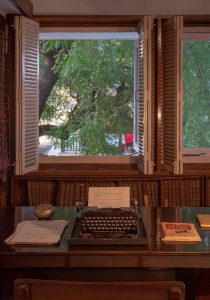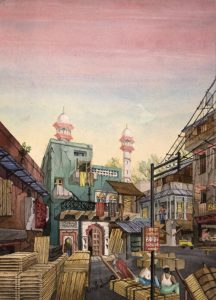THE BEGINNING OF A LIFETIME OF WRITING

Ruth was a prolific writer. She began writing in German as a young child, and changed to her adopted language, English, in England. She saw herself as a cuckoo or chameleon, landing in the nest of others or changing her colors to become one with those around her, to observe them quietly and closely, in order to tell the story of her characters.
England, 1939. My first entirely instinctive demonstration of my cuckoo or chameleon qualities, I took to England, and English, immediately. Up till then my language had been German. I haven't mentioned that I was writing furiously all through my childhood. It doesn't seem worth mentioning - one is just born that way: destined. One doesn't choose to become a writer. I started school at six and learned the alphabet, and then we were told to write our first composition. The subject: a hare - in German, der Hase. I wrote the title, 'Der Hase'. At once I was flooded with my destiny: only I didn't know that's what it was. I only remember my entire absorption, delight, in writing about - giving my impression of - der Hase. To think that such happiness could be!
WRITING IN INDIA
 When she came to India, she left Europe behind and began to write about her new world. For many years, Ruth was known as an “Indian” writer. Her first published stories were in India and about Indians, and for years her readers thought they were reading an Indian writer.
When she came to India, she left Europe behind and began to write about her new world. For many years, Ruth was known as an “Indian” writer. Her first published stories were in India and about Indians, and for years her readers thought they were reading an Indian writer.
“All the time I was writing those early books and stories of mine. They were all about India - set in India and all the characters Indian. I was pretending to be writing as an insider, as if I didn't know anything else. As if I wasn't a European at all, had never heard of such a place. I don't know how I had the impudence to write like that - in English, in my careful precise (maybe even prissy) prose style learned in England via English literature classes - about people who didn't ever think in English, let alone speak it. But I pretended I knew them - no, more, I pretended I was them. For instance, I was always fond of writing about great big beautiful sensual Indian women, full of passion and instinct; the very opposite of myself, physically and in every other way. And I wrote about them, was them, wanted to be them. All this is quite inexplicable to me: those ten years of delight and immersion and more (much more) than acceptance.”
WRITING IN NEW YORK
 In 1975, Ruth won the Booker Award, the first of many awards, for her novel, Heat and Dust. This award enabled her to move to New York, where she quickly began to set her novels in America, although always having Indian and English characters appear as well. Her first novel based in New York was In Search of Love And Beauty (1983). She was awarded a Guggenheim Fellowship in 1977 and a MacArthur Genius Award in 1984 (among the many awards she received in her lifetime). She continued to be extremely prolific, publishing many novels and short stories while writing her most successful movies at that time.
In 1975, Ruth won the Booker Award, the first of many awards, for her novel, Heat and Dust. This award enabled her to move to New York, where she quickly began to set her novels in America, although always having Indian and English characters appear as well. Her first novel based in New York was In Search of Love And Beauty (1983). She was awarded a Guggenheim Fellowship in 1977 and a MacArthur Genius Award in 1984 (among the many awards she received in her lifetime). She continued to be extremely prolific, publishing many novels and short stories while writing her most successful movies at that time.
In New York, Ruth found many people from her childhood living there and wrote about them. She now added Americans to her cast of characters.
Literally I met the people who should have remained in my life - people I went to school with in Cologne, with exactly the same background as my own, same heritage, same parentage. Now here they were living in New York, as Americans, in old West Side apartments, with high ceilings and heavy furniture, just like the ones we grew up in in our Continental cities (as blissfully overheated as my grandparents' flat in Cologne)’.
RUTH THE MASTER STORY-TELLER

Above all, Ruth was a master story-teller. In her simple and beautiful prose, she told gripping stories of people mired in their circumstance, longing for lives other than their own. She writes of people who find themselves in bewildering scenarios where the world around them has changed and they struggle to understand it. Writing about her characters and conflict: I have to admit that none of this came to me consciously but evolved within the situation itself. So by the time I had finished writing (as often happens to me at the end of a story) I looked at it and wondered: ‘So that’s what it was all about.’”
Through the keen observation of her genius, Ruth was able to tell stories of people and places, starting with her first novel, To Whom She Will, published in 1955, when she was only 28 years old and ending with her last short story, The Judges Will, published in March, 2013 in The New Yorker, a few weeks before her death.
Her good friend, the writer, Anita Desai, in an introduction for a posthumous collection of Ruth’s stories wrote: Hers was a total absorption. Ruth, like a great actress, becomes her characters and presents them to us from the inside out, not the outside in. She does not criticize them or satirize them…she becomes those she portrays.